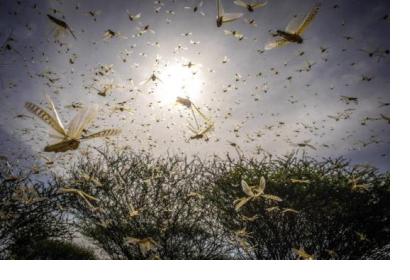On 12 June, the United Nations Office for Outer Space Affairs (UNOOSA), through its UN-SPIDER programme, and the International Water Management Institute (IWMI) hosted a webinar on “Space-based inputs for locust early warning and preparedness” as a commitment to promote the use of space technologies in combating a crisis that is mounting on top of the COVID-19 pandemic.
The recording of the webinar is available online.
During the 90-minute session, experts from UNOOSA, IWMI, India, Pakistan as well as from other international organizations, governments and private agencies discussed how space applications can strengthen the monitoring and early warning efforts to prevent the locust outbreak in future.
Opening session
| Panelist | Affiliation | Topic |
|---|---|---|
| Mr Shirish Ravan | Head, UN-SPIDER Beijing Office, UNOOSA | Housekeeping and setting the tone |
| Ms Simonetta Di Pippo | Director, UNOOSA | Opening remarks |
| Mr. Mark Smith | Deputy Director General, IWMI | Opening remarks |
Panel discussion
| Panelist | Affiliation | Topic |
|---|---|---|
| Mr S. N. Sushil | ICAR-Agricultural Technology Application Research Institute, India | Facts: Management of the desert locust outbreak (Presentation) |
| Mr Giriraj Amarnath | International Water Management Institute, Sri Lanka | Satellite data monitoring of the impact of locust for preparedness and response planning (Presentation) |
| Mr Raj Kumar | Space Applications Centre, Indian Space Research Organisation, India | Space-based assessment of desert locust menace to Indian summer crops (Presentation) |
| Mr Ibrar ul Hassan Akhtar | Space and Upper Atmosphere Research Commission, Pakistan | Desert locust geospatial monitoring system (Presentation) |
| Q & A | ||
| Mr Wenjiang Huang | Aerospace Information Research Institute, Chinese Academy of Sciences, China | Role of AIR in supporting locust monitoring and assessment using aerospace technologies (Presentation) |
| Mr Swapnil Chaudhari | Pathway Technologies, Nepal | Role of ICT tools and technologies for locust preventive measures (Presentation) |
| Mr Erick Fernandes | World Bank’s Agriculture Observatory | World Bank’s role in the desert locust control (Presentation) |
| Ms Sarah Bashir and Mr. Iftikar Abbas | World Food Programme, Pakistan | Use of remote sensing, GIS and mVAM for locust loss and needs assessments (Presentation) |
| Q & A | ||
| Mr Keith Cressman | Food and Agriculture Organization of the United Nations (FAO) | Way forward and guidance on locust forecasting |
Background on current locust impact globally
Swarms of desert locusts are threatening large areas of pastures and crops, overwhelming countries in the Horn of Africa, the Middle East, and South Asia. The UN Food and Agriculture Organization (FAO) says these swarms represent the worst infestation in 25 years in Ethiopia and Somalia, in 26 years in India, and the worst in 70 years in Kenya. The crisis has affected 23 countries to date, from Pakistan to Tanzania. This is a single global outbreak, and if it reaches plague levels, it could cover 20 per cent of the earth’s landmass.
Farmers across Pakistan and Indian states are suffering the worst plague of locusts in recent history, which has caused billions of dollars in damage and led to fears of long-term food shortages. The locust crisis overlaps with the COVID-19 pandemic, creating a crisis within a crisis. Local agri-food supply chains are already experiencing disruptions, including reduced access to inputs and services, labour movement, transport and roadblocks, and credit or liquidity due to COVID-19. These crises have the potential to generate a condition of famine, disease and poverty.
Space technology including satellite data offers a handy tool for locust impact monitoring, and early warning. The data are used for assessing the current situation, forecasting its developments and planning an effective response at all levels. Satellite-derived vegetation data and essential climate variables derived from, for example MERRA-2 data of NASA’s Global Modeling and Assimilation Office (GMAO) are used to alert authorities in preventing the spread of desert locust swarms and helps protect the crops of smallholder farmers. The MODIS-derived dynamic greenness map (250 m), as well as the satellite-based rainfall map, can be used by authorities when moving in the field which is implemented using Google Earth Engine. These are some of the examples of adopting innovative technology for use in the locust affected region.
To find out more about space applications to fight the global crisis, please visit:
- UN-SPIDER Data Application of the Month
- UN-SPIDER COVID-19 page
- International Water Management Institute
- News article on spread of desert locust in South Asia (3 June 2020)
- FAO Desert Locust Situation Update 4 June 2020
The webinar also covered what UNOOSA and IWMI are doing to help all countries access the potential of space science and applications for achieving the Sustainable Development Goals (SDGs) and integrate these tools in national policies and practices.

